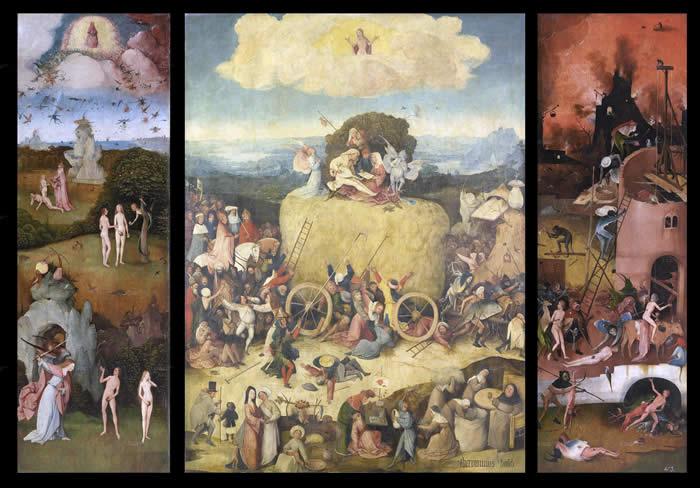
The Haywain
-commentaries by Lee van Laer
Slide show, left panel, with full commentary
coming soon...
Slide show, center panel, with full commentary
coming soon...
Slide show, right panel, with full commentary
coming soon...
This painting, alongside Hieronymus Bosch's The Garden of Earthly Delights stands as one of the greatest masterpieces of the Northern Renaissance —or, indeed, any age.
The paintings are actually companion pieces. The Garden of Earthly Delights is Bosch's representation of the inner life of man; The Haywain is a representation of his outer life. There are hundreds of points of comparison to support this contention, including the fact that they share an identical symbolic language, pictorial format, compositional architecture, and order of reading. These two paintings were always meant to go together; and it's clear that the Haywain was painted second, based strictly on dendrochronology dating.
As such, the paintings are mirrors of one another. The Garden of Earthly Delights summarizes man's inner or esoteric life, his spiritual life, the life of his consciousness and his soul; and The Haywain summarizes his outer or exoteric life, his life on earth, his struggles on the surface of the planet. They both start out in a recognizably similar heaven; and they both end in a nearly identical hell. The symmetry of the starting and end points underscores the two intentionally different currents that flow through the story lines of the paintings
Both paintings are actually books to be read. Each one, given an understanding the symbolic language, can be read in a specific order to see an entire story about their central subject. This approach was to be expected in a time when literacy was at a very low level; teachings about subjects, especially religious and esoteric subjects, were often passed on using pictorial methods. The greatest examples of these that still remain today are the stained-glass panels in the great cathedrals of the Middle Ages, especially Chartres. It is no surprise to discover, in the end, that Bosch's paintings use the same well-known method. What may be more surprising is to discover that they convey not some bizarre, whacko set of hallucinatory visions, but a deeply organized, intelligble, rich, and utterly extraordinary set of messages about the religious and inner life of man.
Like its companion painting, there are three levels of influences in the painting: exoteric, or outer influences, in the foreground, mesoteric, or transitional, influences in the middle ground, and esoteric, or inner and divine, influences in the background.
The center panel of each painting defines its subject matter. The Garden of Earthly Delights contains no traces of the outer life of man in its center panel; there are no man-made objects, professions, activities, casts, trades, elites, or other indicators of man's outer life.
The Haywain's center panel has almost nothing but such images. The artist made the differences between the two so patently obvious that it is difficult to misunderstand the intention, once one sees it. In both paintings, as the commentaries will make clear, the artist took great care to make sure his message could be easily and clearly read. Centuries of obfuscating academic interpretations have clouded our understanding of these works, which stand as the greatest masterpieces of esoteric visual art in Western history.
A commentary on Bosch's symbolism
Contact
Lee's blog on esoteric matters
Other esoteric studies
A Doremishock resource; all material copyright 2013 by Lee van Laer